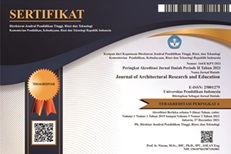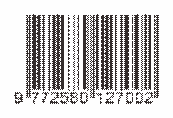PLACE ATTACHMENT STUDY IN KUTA BEACH COMMERCIAL CORRIDOR
Abstract
Kuta Beach has undergone a change in function and a shift in activity which began with the opening of the trading port function to become a popular beach tourism area in Bali. The development of tourism on Kuta beach is currently experiencing a very drastic increase as evidenced by the very rapid development of tourist accommodation and infrastructure arrangement by the government. The increase in the number of hotels, inns and various other types of functions indicates the high interest in investment in the Kuta beach road area. Indirectly, this dynamic changes one's bond in the Kuta Beach corridor. The study of Place attachment in the commercial corridor area of Kuta Beach aims to determine the important factors in the formation of a place's identity, corridor characteristics, visitor preferences, activity studies, and magnetic identification of an area. The research method in place attachment studies in the Kuta beach corridor uses a quantitative approach accompanied by a qualitative descriptive explanation to find out the phenomena and perceptions of visitors. Knowing the important variables and elements in the corridor becomes the focus of the study to obtain data on the level of place attachment that exists in the commercial corridor of Kuta beach. Based on the literature study, the place attachment study is one of the cornerstones in assisting the planning of an area by assessing the level of attachment to a place.
Keywords
Full Text:
PDFReferences
Giuliani, M. V. (2003) ‘Theory of attachment and place attachment. In M. Bonnes, T. Lee, and M. Bonaiuto (Eds.)’, Psychological theories for environmental issues, (January 2003), pp. 137–170. Available at: https://www.researchgate.net/publication/228091197%0ATheory.
Grace S., Imam S, A. S. (2015) ‘Gender dan Place Attachment pada Coffee Shop di Bandung’, Jurnal Sosioteknologi, 14(3), pp. 298–310. Available at: https://doi.org/10.5614/sostek.itbj.2015.14.3.8.
Halpenny, E. A. (2010) ‘Pro-environmental behaviours and park visitors: The effect of place attachment’, Journal of Environmental Psychology, 30(4), pp. 409–421. doi: 10.1016/j.jenvp.2010.04.006.
Hidalgo, M.C.; Hernandez, B. (2001) ‘PLACE ATTACHMENT : CONCEPTUAL AND EMPIRICAL QUESTIONS’, Journal of Environmental Psychology, pp. 273–281. doi: 10.1006/jevp.2001.0221.
I S Wijaya, W Purnamasari, D. S. (2018) ‘Defining place attachment in community base development program for urban settlement – a theoretical review’, Earth and Environmental Science, 202. doi: 10.1088/1755-1315/202/1/012052.
Mantey, D. (2015) ‘The role of public spaces in creating place attachment ( example of Zacisze , Warsaw housing estate ) The role of public spaces in creating place attachment ( example of Zacisze , Warsaw housing estate )’, Miscellanea Geographica – Regional Studies on Development. doi: 10.1515/mgrsd-2015-0013.
Rubenstein, harley M. (1978) Central Mall City. New York: Wiley Intersciene Publication.
Scannell, L. and Gifford, R. (2010) ‘Defining place attachment: A tripartite organizing framework’, Journal of Environmental Psychology, 30(1), pp. 1–10. doi: 10.1016/j.jenvp.2009.09.006.
Sugiyono (2010) Metode Penelitian Kuantitatif Kualitatif dan R dan D. Bandung: Alfabeta.
Tuan, Y.-F. (1977) Space and Place The Perspective of Experience. University of Minnesota Press.
Ujang, N. (2012) ‘Place Attachment and Continuity of Urban Place Identity’, Procedia - Social and Behavioral Sciences, 49, pp. 156–167. doi: 10.1016/j.sbspro.2012.07.014.
DOI: https://doi.org/10.17509/jare.v3i2.37837
Refbacks
- There are currently no refbacks.
Copyright (c) 2021 Journal of Architectural Research and Education

This work is licensed under a Creative Commons Attribution-NonCommercial-ShareAlike 4.0 International License.

This work is licensed under a Creative Commons Attribution-ShareAlike 4.0 International License.








